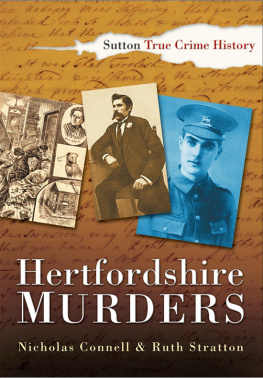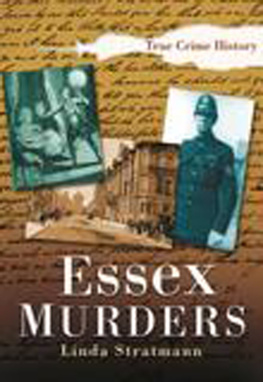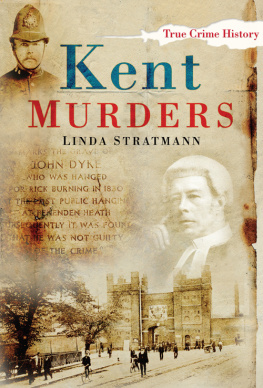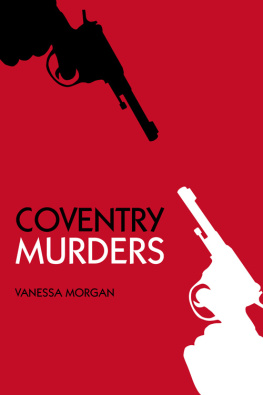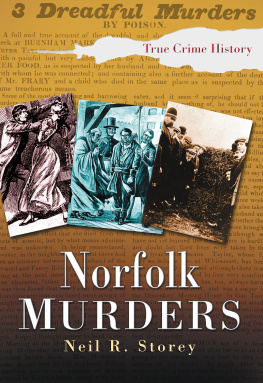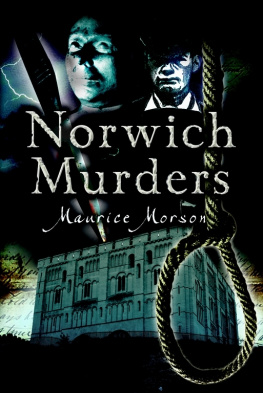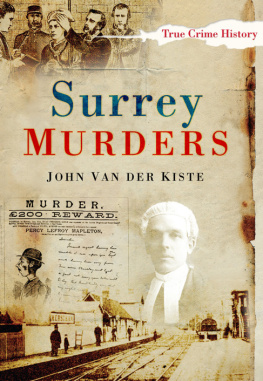Hertfordshire
M URDERS
Nicholas Connell & Ruth Stratton


For Richard Whittington-Egan
First published in 2003 by Sutton Publishing Reprinted 2007
Reprinted in 2011 by
The History Press
The Mill, Brimscombe Port
Stroud, Gloucestershire, GL5 2QG
www.thehistorypress.co.uk
This ebook edition first published in 2013
All rights reserved
Nicholas Connell & Ruth Stratton, 2011, 2013
The right of Nicholas Connell & Ruth Stratton to be identified as the Authosr of this work has been asserted in accordance with the Copyright, Designs and Patents Act 1988.
This ebook is copyright material and must not be copied, reproduced, transferred, distributed, leased, licensed or publicly performed or used in any way except as specifically permitted in writing by the publishers, as allowed under the terms and conditions under which it was purchased or as strictly permitted by applicable copyright law. Any unauthorised distribution or use of this text may be a direct infringement of the authors and publishers rights, and those responsible may be liable in law accordingly.
EPUB ISBN 978 0 7509 5285 9
Original typesetting by The History Press
CONTENTS
ACKNOWLEDGEMENTS
T he authors would like to thank the helpful staff of the British Library, the British Library Newspaper Library, Corporation of London Records Office, Hertford Museum, Hertfordshire Archives and Local Studies, Hertfordshire Central Resources Library, the National Archives and St Albans Library.
We should also like to thank the following people for their help: our colleagues at Hertfordshire Archives and Local Studies, Margaret Ashby, Alex Chisholm, Susie Elliott, Stewart Evans, Ken Griffin, Stuart Lee, Jeremy McIlwaine, Sarah Moore, David Mossop, Hugh Noblett, Jon Ogan, Phil Sugden, Geoff Webb, Molly Whittington-Egan and Richard Whittington-Egan.
INTRODUCTION
T he crime of murder has always held a macabre fascination. What drives a human being to slay a fellow creature in cold blood, a father to batter his sweetheart and child, a young man to butcher his fiance and an unknown assailant to strangle an innocent seventeen-year-old girl and stash her body in a deep freeze? These are just some of the chilling true stories found in the pages of Hertfordshire Murders.
Hertfordshire is one of Englands smallest counties yet it is crammed with a rich historical heritage; a county where fragments of a Roman past still linger and significant battles have been fought. Yet despite its proximity to London, Hertfordshire has retained its rural charm. With its scenic countryside, village curiosities and quiet woodland lanes, it has been the chosen residence of many royals and landed gentry in the past. It is no wonder this is still one of the most desirable counties in the South East. But not even this Home County idyll can escape the dark stain of murder.
Hertfordshires murderous past is well documented in the countys records, but occasionally only a tantalising glimpse into a long-forgotten atrocity remains. The famous Hitchin historian Reginald Hine (18831949) noted that eight murders were committed in that historic market town in the year 1278 alone. The burial register for St Margarets church, Barley, contains reference to a murder in 1598 of John Millisent of norwiche slaine in the fielde by one of the same cittye, leaving the reader hungry for more details about a story that will never now be told. More horrifying is an entry in the burial register of St Peters church, Great Berkhamsted. On 17 March 1664 Robert Toefeild was buried, having been poysoned by his wife [who was later] burnt alive at Hertford.
There have been a great number of murders in this county that caused a stir both locally and nationally. When newspapers became readily available in the early nineteenth century they spared little in satisfying the publics thirst for minute detail. This is best illustrated in Aldenham in 1823, when John Thurtell blasted his way into national notoriety with the killing of William Weare, thanks to the unparalleled coverage by the national press.
A collection of the most infamous cases in the county are examined in the following pages, using extensive sources from forgotten broadsheets to previously closed police files, witness statements and court transcripts. Some remain a mystery, but all are part of the murky criminal heritage of Hertfordshire.
SOME
HERTFORDSHIRE
TRAGEDIES
B uried amid the prodigious collection of the great Hertfordshire antiquarian William Blyth Gerish (18641921) there is a 103-page manuscript entitled Some Hertfordshire Tragedies. It was written in 1913 when Gerish was living at Warwick Road, Bishops Stortford, and like too much of that worthy gentlemans work it never saw publication. The manuscript covers a variety of unpleasant and gruesome episodes in Hertfordshires history including some unusual murder stories.
Gerishs first entry related to a skeleton uncovered during an archaeological dig at Hinxworth. The bones were believed to be those of a man who died aged about sixty over 10,000 years previously as a result of a tap from a flint axe on the top of his cranium. Moving forward to the fifteenth century there was the story of James Roche, vicar of Sarratt in the Year of Grace 1462. The Register for the second Abbacy of John of Wheathampstead contained the following entry:
On the 14th day of June the Vicarage of Saret [sic] was given to John Skeltone chaplain; the same being notoriously vacant because James Roche, the late vicar there, with his wicked abettors, namely, Roger Wittone, Esquire, and other strangers unknown, slew and murdered Richard Glowcestre, his parishioner, an artificer, with one Hogheler [another accomplice] and secretly buried him in a certain field belonging to the said Roger Wittone, on Sunday the 16th day of May, in the same year; and the said James Roche, who was vicar there, for this reason, took to flight.
Other finds unearthed by Gerish included a tract at the British Museum called The Horrible Murther of a Young Boy of three years of age, whose Sister had her tongue cut out: and how it pleased God to reveale the offenders, by giving speech to the tongueless childe. Which Offenders were executed at Hartford the 4 of August, 1606.
According to the tract this cause clbre involved a boy and a girl who were staying at an inn and common lodging house in Hatfield kept by a couple named Dell. The boys body was later found with a great peece of wood tyed to his backe, while his sister was discovered trapped in a hollow tree with her tongue cut out. The Dells were arrested but denied all knowledge of the murder and mutilation. They were bound over from one Assize court hearing to the next between 1602 and 1606. The girl had wandered the country in those years and in 1606 she found herself back in Hatfield where she miraculously regained the power of speech and gave evidence against the Dells at the Hertford Assizes. The Dells were subsequently found guilty of murder and mutilation by a jury who had earlier looked into the childs mouth, but could not see so much as the stumpe of a tongue therein.
Confirmation that this story was based at least partly on true events can be found in the Assize calendar for 1 August 1606, at which date George Dell, a baker, and Agnes Dell, a widow, were indicted for the murder of Anthony James on 4 July 1602. George Dell had cut the boys throat with a knife and thrown the body into a pond. Both Dells were sentenced to death.
While trawling the British Museums collections for material relating to Hertfordshire, Gerish discovered another seventeenth-century pamphlet with an even grander title,
Next page
